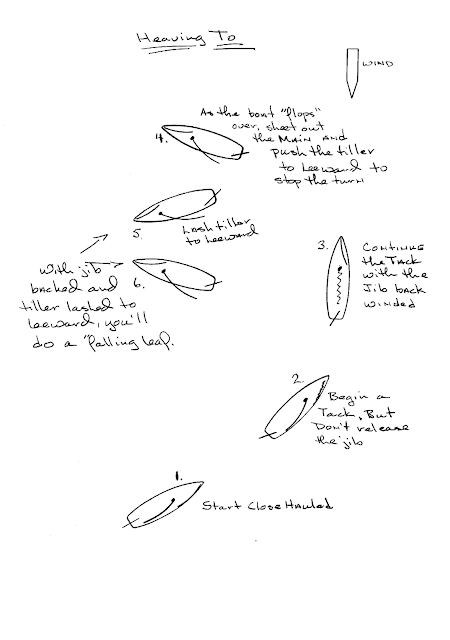Heaving To
Heaving
To is one of those sailing skills that many have heard about, but few have
practiced. It is a skill that has many
benefits. Here are just a few of the
great reasons to know how to heave to:
1. If
you’re sailing single-handed, you can take a break from steering without
dousing the sails.
2. You
can also fix and eat lunch, take a nap, go to the head, change clothes, etc –
all with the sails still up, but the boat Hove To.
3. Heaving
To makes fixing and repairing things go quickly and easier.
4. Reefing
the mainsail single handed or short handed goes easier if you’re Hove To.
5. You
can plot your position on the chart without having the boat move significantly
while you’re doing this basic navigational chore.
So,
what is Heaving To? Simply it is
adjusting the jib sail so that the jib is back-winded while the mainsail is
sheeted out to about a beam reach setting.
One way to do this would be to release the loaded jib sheet while
sailing and pull the jib’s clew to windward with the windward jib sheet. This is quite a bit of work if there’s too
much breeze blowing.
An
easier way to Heave To is to simply tack the boat without releasing the
old loaded jib sheet. As the boat comes
through the eye of the wind, stop the boat’s turn by moving the tiller to
leeward and ease the mainsheet. As the
boat comes to a stop, you’ll notice that your boat will perform sort of a
“falling leaf” motion on the wind and waves with first the jib backing and pushing
the bow away from the wind and then the main filling and the boat rounding
up. Adjusting the tiller or wheel to
help the boat round up will complete Heaving To, and you will jog along on the
waves and wind at about one knot or so with very kindly boat motion.
Practice Heaving To on nice days with
5 to 10 knots of breeze. It’ll only take
a couple tries to figure everything out.
Then keep this maneuver in mind for those situations where you want to
stop steering and there’s no one else who really wants to steer.


b.jpg)